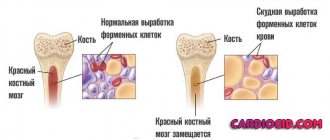D-dimer is a protein that rises in the blood after blood clots form and break down. It consists of parts of fibrin threads (a mesh that holds and fixes the blood clot). The study is necessary if there is a threat of blockage of veins or arteries by a blood clot: pulmonary thromboembolism, heart attack, stroke, DIC in severe (shock) condition, pregnancy complications. In all of these conditions, D-dimer is elevated. Inflammation, tumors, and liver disease lead to false results.
To reduce indicators, low molecular weight heparin (Fraxiparin, Clexane), antiplatelet agents (Aspirin, Curantil), and angioprotectors (Angiovit) are used. Folk remedies (tea with raspberries, ginkgo biloba decoction) are of auxiliary value, like dietary nutrition; they do not give the desired effect without medications.
What is D-dimer
D-dimer is a product of dissolution of thrombotic masses
D-dimer is a protein fragment formed during the dissolution of blood clots. Diagnosis of D-dimer concentration allows one to identify thrombotic phenomena in the bloodstream, and the most significant result is negative, that is, the absence or very low value of D-dimer in the blood indicates the exclusion of thrombosis with a probability of 80 to 100%, depending on the diagnostic method.
The circulatory system is protected from blood loss by the hemostasis system. When the integrity of the vessel is damaged, a mechanism is triggered to create a blood clot, which prevents bleeding from developing. The process consists of a sequential chain activation of blood clotting factors. In the last phase, the plasma protein fibrinogen is cleaved by the enzyme thrombin and converted into fibrin monomer, which forms the basis of a blood clot. Under the influence of plasma glycoprotein, fibrin becomes a polymer, forming threads that hold the blood clot.
D-dimer is a product of the destruction of a clot formed from fibrin strands. It is formed at the stage of fibrinolysis - the process of destruction of a blood clot. The hemostasis system initiates this mechanism to eliminate blood clots and keep the blood fluid. D-dimer is a complex molecule containing two fragments of fibrinogen. Compared to other derivatives of fibrin thrombus breakdown, it is the largest and most stable element, which makes it possible to use its value in diagnosis.
Briefly about young analysis
The fact that after the breakdown of a blood clot certain protein substances appear, representing two (D-dimer) fragments of fibrinogen, became known already in the 70s of the last century, but for another 20 years the features of these fragments were not used in clinical laboratory diagnostics due to insufficient knowledge. But in the 90s, D-dimer came into practice as one of the main laboratory tests that allows diagnosing thrombotic conditions in the early stages of their development.
Currently, this laboratory indicator is used not only by large specialized clinics; every medical institution that has special laboratory equipment and considers itself capable of providing emergency assistance in acute pathological conditions of the hemostatic system strives to have in its arsenal a kit for determining D-dimer. This approach helps to start therapeutic measures in a timely manner and, thereby, save the patient’s life.
Normal indicators
Low values or absence of D-dimer is a normal variant
The norm for a healthy person is the absence or very low value of D-dimer, since its formation occurs only when the fibrin clot dissolves. The active manifestation of a protein enzyme in the blood means that the blood coagulation system was involved.
Reference values are: 0 - 0.5 µg/ml.
But during pregnancy, the indicators increase, since the circulatory system operates in a different mode. With each subsequent trimester, the concentration of D-dimer increases, which is the norm. Reference values during pregnancy:
- I trimester: 0 - 0.55 mg/ml;
- II trimester: 0.2 - 1.7 mg/ml;
- III trimester: 0.3 - 3.1 mg/ml.
Indications of D-dimer during pregnancy and reasons for its study
During pregnancy, D-dimer increases, as the blood coagulation and anticoagulation systems (fibrinolysis) are simultaneously activated. Already in the early stages it increases, and in the later stages its concentration reaches an almost fivefold increase (see table by week).
| Weeks of pregnancy | D-dimer norm in ng/ml | D-dimer norm (µg FEU/ml) |
| Up to 13 | Up to 286 | 0-0,55 |
| 13-20 | Up to 450 | 0,22-1,35 |
| 21-28 | Up to 475 | 0,3-1,65 |
| 29-35 | Up to 580 | 0,3-2,95 |
| 36 and until birth | Up to 645 | 0,4-3,1 |
Signs for which the gynecologist refers for analysis:
- severe weakness
- headache,
- nausea, vomiting,
- spotting bloody discharge,
- stomach ache,
- swelling,
- high blood pressure,
- protein in urine.
Diseases in which high D-dimer occurs in a pregnant woman:
- diabetes mellitus or gestational diabetes;
- kidney damage - nephropathy, pyelonephritis, glomerulonephritis;
- venous circulation disorders - varicose veins, venous insufficiency, phlebitis, thrombophlebitis;
- liver – hepatitis, hepatosis;
- infections – viral, microbial;
- exacerbation of chronic inflammation of internal organs (for example, gallbladder - cholecystitis, pancreas - pancreatitis);
- complications - toxicosis, eclampsia, threatened miscarriage, placental abruption.
An increased rate is dangerous due to increased thrombus formation and deterioration of fetal nutrition, as blood flow through the vessels of the placenta weakens.
If throughout pregnancy or in the later stages the D-dimer is low, this means that there is a risk of severe bleeding during childbirth. In case of concomitant diseases, especially renal pathology and hormonal disorders, control of blood clotting must be carried out at the stage of planning conception.
Watch the video about D-dimer during pregnancy:
Increased values: reasons
Increased D-dimer in deep vein thrombosis
A high concentration of the protein fragment indicates a constant process of dissolving blood clots, that is, the struggle of the circulatory system with the resulting blood clots.
Causes:
- deep vein thrombosis (DVT);
- pulmonary embolism (PE);
- disseminated intravascular coagulation (DIC syndrome);
- pathologies of the cardiovascular system;
- neoplasms;
- thrombolytic treatment.
The increase in the concentration of the protein fragment can be affected by various inflammatory phenomena, pathological processes in the liver, surgical interventions, injuries, the period of gestation, as well as the advanced age of the patient. Therefore, a diagnosis cannot be made based on a high D-dimer test value alone. An increased result is a reason to conduct additional studies to identify possible pathological thrombus formation.
What influences the result of the study
Depending on the stage of pregnancy, the result may show different values.
The following factors influence the maximum level of protein enzyme content:
- multiple pregnancy;
- suffered miscarriages, abortions;
- non-developing pregnancy;
- 2 or subsequent pregnancies.
If the identified markers are assessed as high or close to the threshold of the maximum value, the woman is at risk. This can lead to future pathology for the mother or fetus. Therefore, in such cases, in order to preserve the health of the baby and the woman, she is often hospitalized to maintain the situation.
D-dimer during pregnancy may be below normal if protein fractions are not expressed in relation to the coagulological properties of the blood. The rare disease does not manifest itself immediately, but gradually, which is considered a direct threat to the development of bleeding immediately before and after childbirth.
Reduced values: reasons
A laboratory error may produce a falsely low result.
D-dimer is an indicator whose concentration cannot be below normal, since the threshold lower value is zero. Therefore, when they talk about a reduced value, they mean:
- A falsely reduced result due to an incorrect laboratory test.
- Decrease high value. Observed with the administration of heparin, as well as therapy with indirect anticoagulants.
- Idiopathic cause of poor outcome in the presence of other criteria for thrombosis.
Indications for analysis
Chest pain - indications for analysis
To assess the hemocoagulation system, analysis is recommended during pregnancy and in anticipation of surgery. To refute or identify pathologies, the concentration level of D-dimer is used if DVT, PE, or disseminated intravascular coagulation are suspected.
A doctor may refer you for diagnostics if the following signs occur:
- pain in the leg;
- swelling of the limb;
- cardiopalmus;
- chest pain;
- feeling of lack of air;
- bleeding from mucous membranes, hematomas.
How often is D-dimer prescribed during pregnancy?
Doctors recommend taking tests when registering and every trimester. If the first two analyzes gave good results, then the next two are not particularly necessary. If the indicators are normal, but the woman suffers from pain in the legs, migraines, swelling of the veins, pain in the abdomen and changes in skin color, then this is a reason to continue to get tested regularly. The situation can change in any trimester, so you should not rely only on the first data.
There is no need to take medications to reduce or increase D-dimer unless absolutely necessary. Otherwise, the woman runs the risk of severe bleeding and abruption of the placenta ahead of schedule. Only the doctor determines the amount of medications and the duration of their use.
Preparing for analysis
Medicines are discontinued on the eve of the study by a specialist
This analysis does not require special preparation. It is recommended to follow generally accepted rules:
- exclude fatty foods and alcohol the day before diagnosis;
- do not smoke an hour before the test;
- stop taking medications;
- do not overload the body physically and emotionally;
- donate blood in the morning, on an empty stomach.
Method of analysis for D-dimer
There are three methods for studying the concentration of D-dimer, the most widely used is immunoturbidimetry. This technology is based on microlatex agglutination, the result of which is determined using photometry.
The plasma sample is combined with a suspension of microlatex particles coated with anti-D-dimer antibodies. If D-dimers are present in the blood being tested, the optical density increases. The higher the density, the higher the concentration of D-dimers.
Explanation of tests for D-dimer
D-dimer has its own reference values
A negative result excludes diseases associated with increased thrombus formation. If the absence of D-dimer means that there is no pathological thrombus formation, then where do the reference values of up to 0.5 mcg/ml come from and why are numbers different from zero also included in the concept of normal?
In the human body, fibrin is constantly generated in small doses. Its formation is compensated by the continuously occurring process of dissolving clots, thus maintaining balance in the circulatory system.
Coronary heart disease is accompanied by an increase in
The formation of bleeding changes the level of D-dimer, as the coagulation system is activated to create obstacles in localizing the damage to the vessel. The diagnosis is made on the basis of a high level along with other studies and in most cases determines the following pathologies:
- DIC syndrome. Excessive activation of hemostasis, provoking excessive formation of thrombin and fibrin, leads to the formation of microclots in the bloodstream, clogging small vessels. This condition causes disorders of many internal organs.
- DVT. Clots form in the deep vein system of the pelvis, thighs or legs. There is a high risk that blood clots will break off and, moving through the vessels, settle in the lungs. A clot moving through the circulatory system is called embolic; when such a clot enters the pulmonary artery, it causes the following pathology, which is also determined using the level of D-dimer - PE.
- TELA. A thrombus that has penetrated the pulmonary artery obstructs the movement of blood flow. As a result, the blood is less supplied with oxygen, consequently depleting all organs of oxygen. If the clot is large, it is fatal.
- Cardiovascular diseases. With various disorders, for example, coronary artery disease, a narrowing of the arteries of the heart occurs, which leads to a lack of blood supply and a high risk of blocking the artery with a blood clot.
How to treat
An increase or decrease in D-dimer requires immediate treatment. In the first case, a woman’s predisposition to the manifestation of thrombophilia is diagnosed. If pregnancy is difficult, and there are no direct reasons, then changes in the functions of homeostasis are diagnosed.
Elevated
The woman is in hospital treatment. It is also necessary to undergo therapy to help normalize D-dimer levels. Blood thinners, such as Fraxiparine, may be prescribed. Injections are given intramuscularly in the navel area. The anticoagulant can be injected subcutaneously into the thigh for 7 days when tested every morning.
In case of sharp “jumps” in the parameter, additional therapy with Reopoliglucin droppers is carried out. In case of individual intolerance, the drug should be replaced with Activegin or Curantil - a solution is injected intravenously to normalize blood flow in the placenta.
The risk is not termination of pregnancy, but massive bleeding during childbirth, which can be fatal.
That is why it is important to take precautions before labor begins.
Short
As a rule, when parameters decrease from normal, therapy with vitamin complexes is carried out. Vitamins A, E, K may be prescribed.
To control the risk of blood clots during multiple pregnancies, it is necessary to constantly monitor the following indicators:
- Low molecular weight heparin parameter – if it decreases, you need to administer injections in the form of a solution. Clexane is an anticoagulant that allows you to “strengthen” blood vessels and normalize the consistency of blood and plasma. After the injections, a woman may feel a slight tingling sensation in the kidney area. Discomfort goes away within 30 minutes.
- The level of circulating blood volume - this indicator may vary depending on the treatment. If there is a risk of thrombosis during multiple pregnancies, a drip may be prescribed to thin the blood without loss of volume. Drug treatment in a hospital is indicated for women prone to thromboembolism.
- Poor blood flow in the uterine cavity - it is necessary to increase circulation without increasing pressure. The doctor may prescribe drinking plenty of fluids, which helps thin the blood and normalize blood flow.
If there is a sharp decrease in protein fractions to 500 ng/ml, you must immediately contact a hematologist to eliminate the risk of complications in the postpartum period.
Advantage of the test
Determination of D-dimer - a quick and affordable test
Diagnosis of hemostasis using D-dimer has been used since the 1990s, and during this time it has established itself as a highly effective technique for quickly determining thrombus formation processes in the circulatory system.
To identify thrombosis and concomitant diseases, there are various methods: contrast angiography, ultrasound Dopplerography of veins, lung scintigraphy and other techniques. But these studies are not available to every clinic, and do not always accurately determine the presence of blood clots.
Tests based on blood samples that diagnose other markers of the hemocoagulation system take significantly longer to reveal results. For example, diagnosing fibrinopeptide requires excluding all cross-reacting fibrinogen from the plasma sample.
Another advantage of the D-dimer test is that it is independent of the blood sample collection technique. Also, the result is not affected by platelet admixture, which accompanies the diagnosis of other indicators.
A distinctive feature of D-dimers is their resistance to decay; the duration of circulation of molecules in the bloodstream is about 300 - 400 minutes.
How to donate blood
A common question is: is it possible to eat before donating blood to determine the level of D-dimer in plasma?
Testing for D-dimer is carried out according to standard recommendations:
- Blood samples are taken from the cubital vein, on an empty stomach (8-12 hours without eating);
- Before taking the test (at least 2 hours before) you should not smoke;
- The best time to take the test is before 11:00 am;
- Avoid physical activity and nervous tension; It is advisable to sit on a chair and calm down for a quarter of an hour before donating blood.
In order for the result to be reliable, you need to consult a doctor before donating blood and, if necessary, on the advice of a doctor, shortly before testing, stop taking certain medications or indicate information about their use in the analysis form (hormones, aspirin, heparin, antiplatelet agents, contraceptives).
For several days before the test, it is advisable not to eat fatty, fried foods or drink alcoholic beverages.
If you do the analysis after undergoing certain studies and procedures - x-rays, rectal endoscopy, physiotherapy, the results will not be reliable. Therefore, in such cases, testing should be postponed for a time determined by the doctor.
Apart from these general requirements, no special preparation is required for the D-dimer test.
D-dimer correction
Treatment for D-dimer depends on the cause of its increase
Correction of the indicator directly depends on the treatment of the conditions that caused the increase in its level. During therapy, changes in the D-dimer value are examined to assess the state of hemostasis.
Treatment of DVT includes heparin and indirect anticoagulants. If therapy is ineffective, a thrombolysis procedure may be prescribed; another direction in treatment is the introduction of a vena cava filter into the vena cava to catch blood clots. In some cases, there is a need for surgical removal of blood clots.
The diagnosis of pulmonary embolism requires mandatory placement of the patient in a hospital, where, if necessary, artificial ventilation of the lungs, cardiopulmonary resuscitation, and administration of substances stimulating cardiac activity are performed. The patient is given anticoagulant and, in some cases, thrombolytic therapy based on medications. Surgery is possible if treatment is ineffective.
In acute DIC, medical procedures are aimed at saving the patient’s life. Anti-shock measures, plasma transfusions, and artificial ventilation of the lungs are being carried out. To restore the hemostatic system, heparin, the introduction of blood clotting factors into the blood, plasmapheresis procedures, and therapy with drugs to improve microcirculation in organs are used.
Cardiovascular diseases associated with the formation of blood clots include a whole group of pathologies, each of which requires careful analysis. Treatment may include the use of antithrombotic drugs and anticoagulants, but in most cases, urgent surgical intervention is required.











